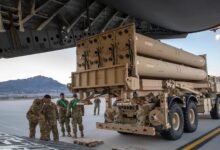The F-35 Can Carry 22,000 Pounds Of Bombs In ‘Beast Mode’

F-35 Beast Mode The F-35’s possible weapons load-out is intriguing, with more bombs and missiles housed externally on its wings as well as armaments in interior bays for enhanced stealth. Internal weaponry aboard the F-35 are normally 5,700 pounds.
It can carry 22,000 pounds of bombs — both internally and externally – in “beast mode.” That’s over four times the amount of explosives. However, this increases the radar cross-section, reducing the radar evasion capability.
First, fight for control of the airspace.
The F-35’s mission is to establish air superiority and domination first and foremost.
Defense planners may envision a mission for the F-35 in the early days of a conflict, when air superiority is on the line, that includes removing big threats in contested airspace and then gathering intelligence, surveillance, and reconnaissance data to learn more about the opponent. This is referred to as “Day One” of a prospective conflict.
Once air supremacy is gained, the F-35 may be equipped with a full complement of missiles and bombs to attack enemy installations and other ground targets, thus serving as a “bomb truck,” as many refer to it. When Lockheed Martin praised the Joint Strike Fighter’s ability to engage in multi-role air combat, he was referring to this.
The Bomb Trucks are Rolling with US Allies
The Royal Australian Air Force trained a beast mode role with the F-35A this summer. Internally, the planes were thought to have a full weapons load of various air-to-air and air-to-ground missiles, but they also had four wing-mounted inert GBU-12 bombs. This was dubbed “beast mode” by many. During the Arnhem Thunder 21 exercise, the Australian jets ended up dropping their external bombs at a range.
The Italian Navy’s F-35B short take-off and vertical landing STOVL variant completed beast mode testing with the aircraft carrier ITS Cavour in the spring of this year, using inert GBU-12 bombs.
In addition to the external bombs, what other weapons are we talking about?
This means two AIM-120 AMRAAM beyond visual range, medium air-to-air missiles; two AIM-9X Sidewinder missiles; six 2,000 pound Joint Direct Attack Munitions, often known as JDAM precision-guided bombs; and the internal 25mm gun for beast mode air-to-ground missions.
Beast mode entails 14 AMRAAMs and two Sidewinders for air-to-air missions. This would most likely happen on “Second Day” missions where air superiority isn’t completely established.
What Effect Does the F-35 Beast Mode Have on Radar Evasion?
Before going into beast mode, make sure you have air superiority. As a result, hostile aircraft and surface-to-air missile systems, as well as radar sites, are rendered useless. In this circumstance, stealth isn’t as vital.
The aeroplane will be more observable by enemy sensors because to Beast mode’s greater radar cross-section. Internally, this is obviously riskier than carrying a lighter weapons load. Air battle planners, on the other hand, would envision a “Third Day” conflict with a significantly degraded enemy, in which stealth is less of a decisive element in the outcome.
All of this requires that Days One, Two, and Three proceed as planned, yet we all know that battle does not often follow such a straightforward pattern. However, F-35 beast mode is a fact, and it demonstrates the Joint Strike Fighter’s total strength.







Facebook Comments